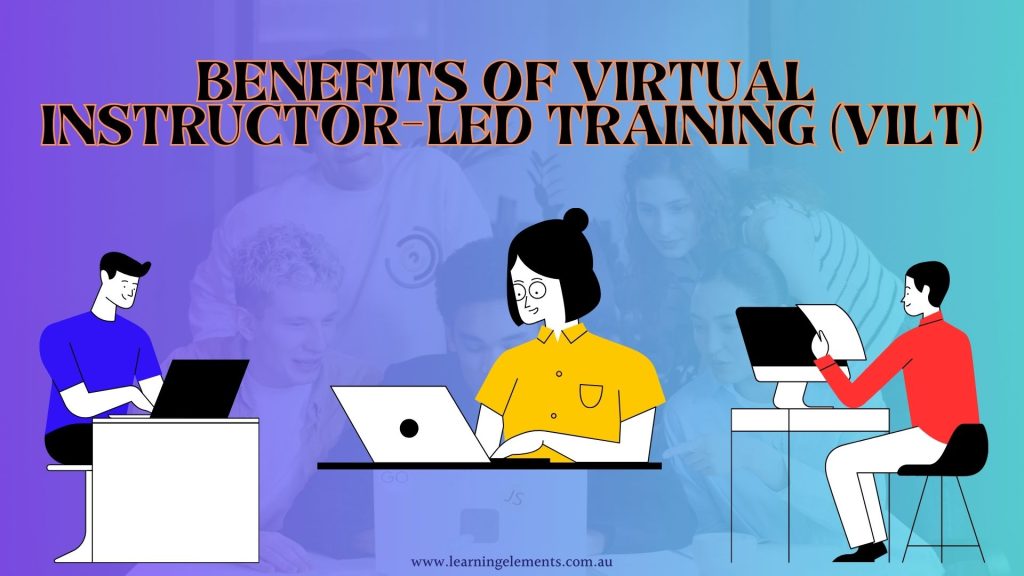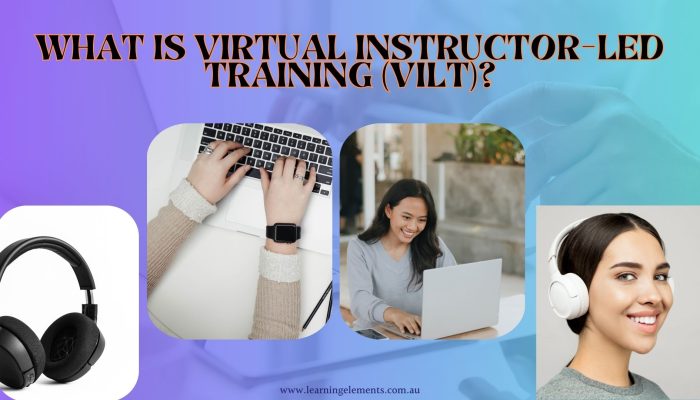The Essence of Virtual Instructor-Led Training (VILT)
Virtual Instructor-Led Training (VILT) is revolutionising how we approach education and professional development. Combining the benefits of traditional classroom settings with the convenience of online platforms, VILT offers a dynamic and engaging learning experience. What makes VILT an essential tool for modern training needs? Let’s find out here.
What is Virtual Instructor-Led Training (VILT)?
Definition of VILT
Virtual Instructor-Led Training (VILT) is a method of delivering educational content in a virtual environment where an instructor guides participants through the material. Similar to a classroom environment, the trainer follows a session plan using a mix of presentations, learning labs, activities, and discussions. The key difference is that learners are offsite, with the training delivered via technology. Unlike self-paced eLearning, VILT involves real-time interaction, allowing for immediate feedback and engagement. Trainers use video and audio to interact with learners, view learners’ screens for step-by-step instruction or demonstrations, and utilise tools like file sharing, screen sharing, breakout rooms, chat, polls, and whiteboards to create interactive sessions.
VILT serves multiple purposes, such as delivering short cross-skill and up-skill training sessions, sales and service training, compliance training, and more. It’s also effective for induction training of any length. However, VILT requires more planning and design to meet learning objectives, ensure engagement, and achieve business goals.
Evolution of VILT
Initially, training was predominantly face-to-face. However, technological advancements have enabled the development of virtual classrooms, bridging the gap between distance learning and the interactive nature of traditional instruction. As technology improved, so did the tools and platforms available for VILT, making it a viable and effective alternative to in-person training.
The Purpose of Instructor-Led Training
Objectives of Traditional Instructor-Led Training
Instructor-led training (ILT) aims to provide structured, guided learning experiences where participants can interact with instructors and peers. It focuses on delivering content effectively, ensuring comprehension, and facilitating the practical application of knowledge.
Adapting these Objectives to VILT
VILT adapts these objectives by leveraging digital tools to replicate the interactivity and engagement of traditional classrooms. The main goal remains the same: to offer a comprehensive learning experience that fosters skill development and knowledge retention.
Benefits of Taking Virtual Instructor-Led Training Course
–Enhanced Engagement
VILT offers a higher level of engagement. The live interaction keeps participants motivated and attentive, fostering a more immersive learning environment.
–Immediate Feedback
One of the significant advantages of VILT is the ability to receive immediate feedback. Instructors can address questions in real-time, helping learners understand concepts more quickly and thoroughly.
–Personalised Learning Experience
VILT allows for a more personalised approach. Instructors can tailor their teaching methods to meet the needs of individual participants, ensuring that everyone benefits from the session.
–Flexibility
Like other forms of e-learning, VILT offers flexibility for students. Whether it’s synchronous or asynchronous learning, participants can access training from anywhere, at their convenience. This flexibility accommodates busy schedules and diverse learning environments, making it accessible to a wider audience.
–Cost-effectiveness
Implementing VILT can result in significant cost savings. By eliminating expenses related to venue rentals, travel, and accommodation, organisations can allocate resources more efficiently and invest in other areas of development.
–Upskilling
VILT plays a crucial role in upskilling employees, addressing skill gaps, and preparing them for evolving job roles.
–Access to Expertise
VILT provides access to expertise that may be otherwise inaccessible in a traditional classroom setting. Employees can learn directly from industry leaders, subject matter experts, and colleagues from different locations, enriching their learning experience and expanding their professional network.
–Scalability
VILT offers scalability without compromising quality. Whether training a small team or a large enterprise, VILT can accommodate unlimited participants, making it ideal for organisations of all sizes. This scalability ensures consistent training delivery and allows for seamless expansion as needed.
–Interactive Learning
VILT promotes interactive learning experiences, leveraging digital tools and technologies to facilitate collaboration, discussion, and knowledge sharing among participants. Interactive features such as polls, quizzes, and breakout sessions enhance engagement and foster a dynamic learning environment.

Types of Virtual Instructor-Led Training (VILT)
- Live Webinars: These are live online sessions where instructors present material and interact with participants in real-time, similar to a broadcast.
- Virtual Classrooms: These recreate a traditional classroom setting online, allowing for a full interactive learning experience using modern course platforms.
- Online Workshops: These sessions focus on interactivity and collaboration, helping participants engage deeply with the material and with each other.
- Blended Learning: This approach combines virtual and in-person learning, integrating VILT seamlessly into the overall educational experience.
- Virtual Labs: These offer hands-on learning experiences online, such as coding labs or other project-based activities, enhancing engagement and practical skills.
- Simulations and Role-Playing: These virtual exercises allow learners to practice skills and scenarios in a controlled online environment, providing valuable hands-on experience.
- Interactive E-Learning with Instructor Support: This format includes pre-recorded courses or modules complemented by live instructor-led discussions, Q&A sessions, and other interactive elements.
- Microlearning Sessions: These are short, focused learning activities designed to deliver bite-sized chunks of information.
- Discussion Forums and Online Communities: These platforms facilitate ongoing interaction and learning among participants outside of scheduled sessions.
- Flipped Classroom: Where learners review content on their own time and use live sessions for discussion and hands-on activities.
Virtual Instructor-Led Training (VILT) for Corporate Training
Importance of VILT in Corporate Settings
In business environments, training needs to be efficient, effective, and scalable. VILT meets these requirements by providing flexible, accessible training solutions that can be tailored to specific organisational needs. Virtual Instructor-Led Training is also cost-effective, helping companies cut costs associated with travel, venue rentals, and printed materials. Additionally, it minimises downtime since employees can participate from their workstations or homes, making it a practical choice for continuous learning and development.
Case Studies of Successful VILT Implementation
Many corporations have successfully integrated VILT into their training programs. Here are a few notable examples:
- IBM: IBM’s VILT approach to employee upskilling combines clear learning paths with industry-recognised credentials and a strong community feel. IBM’s research into skills training found that this approach led to $70,000 in annual savings per employee and a 10% increase in productivity. Additionally, companies using learning technology, like IBM’s VILT, have seen a 16% increase in customer satisfaction.
- Microsoft: Microsoft runs its own employee learning platform, Viva Learning, and emphasises innovative training methods. Microsoft also uses VILT for training vendors and partners through this platform.
- Amazon: Amazon utilises virtual instructor-led training for both employee and public-facing training. A prime example is the AWS training platform, which offers comprehensive VILT courses.
Traditional ILT Versus Virtual Instructor-Led Training
Traditional ILT takes place in a physical classroom, while VILT is conducted online. This fundamental difference influences the delivery, accessibility, and flexibility of the training. Traditional Instructor-Led Training (ILT) excels in hands-on training scenarios where physical presence is crucial, such as laboratory work or equipment handling. On the other hand, Virtual Instructor-Led Training (VILT) is advantageous for geographically dispersed teams, allowing participants to join from anywhere. VILT also offers greater scheduling flexibility and can be more cost-effective.
Components of Effective VILT
Qualified Instructors
The success of VILT depends on the quality of the instructors. They must be adept at using virtual tools and able to engage participants effectively in an online environment.
Interactive Tools
Tools like polls, quizzes, breakout rooms, and chat functions enhance interactivity, making sessions more engaging and effective.
Structured Curriculum
A well-structured curriculum is essential for VILT. It should be designed to facilitate gradual learning with clear objectives and outcomes.
Technological Requirements for Virtual Instructor-Led Training
Essential Hardware
Participants need a reliable computer, a high-speed internet connection, and audio-visual equipment (like a webcam and microphone) to engage fully in VILT sessions.
Recommended Software
Platforms such as Zoom, Microsoft Teams, and Adobe Connect are popular choices for VILT, offering various features to enhance the learning experience.
Challenges in VILT
- Technical Difficulties: Technical issues can disrupt the learning process. Common problems include connectivity issues, software glitches, and hardware malfunctions.
- Engagement Issues: Keeping participants engaged in a virtual environment can be challenging. Distractions at home and a lack of physical presence can reduce attention spans.
Overcoming VILT Challenges
- Technical Support Solutions: At Learning Elements, we understand that providing strong technical support is crucial for a smooth VILT experience. This includes conducting pre-session tech checks, offering real-time troubleshooting, and providing detailed guides for using the required software.
- Techniques to Boost Engagement: We employ various techniques to maintain high levels of engagement during our VILT sessions. Instructors at Learning Elements use interactive activities, regular breaks, and encourage participation through discussions and questions.
How to Choose the Right Virtual Instructor-Led Training (VILT) Provider
Key Criteria
When selecting a VILT provider, consider their expertise, the quality of their instructors, the interactivity of their platform, and their track record of success.
Questions to Ask Providers
Ask potential providers about their experience with similar organisations, the support they offer, and how they measure the success of their training programs.
Have questions? Book a 30-minute consultation with us today!
Preparing for a VILT Session
- Pre-Session Checklist: Ensure you have the necessary hardware and software, a quiet and distraction-free environment, and any required materials or pre-reading completed.
- Best Practices for Participants: Participate actively, take notes, ask questions, and engage with both the instructor and fellow participants to maximise the learning experience.
Maximising the VILT Experience
- Active Participation Tips: Stay engaged by participating in discussions, using interactive tools, and applying what you learn in practical scenarios.
- Utilising Post-Session Resources: Take advantage of recordings, additional readings, and follow-up activities to reinforce learning and apply new skills.
FAQs
- What is the difference between VILT and eLearning? VILT involves live, interactive sessions with an instructor, whereas eLearning is typically self-paced with pre-recorded materials.
- Can VILT be as effective as traditional classroom training? Yes, VILT can be just as effective, especially with the use of interactive tools and real-time feedback from instructors.
- How do I know if VILT is right for my organisation? Consider your training goals, the geographic distribution of your team, and your budget. VILT is particularly useful for remote teams and organisations looking to reduce travel costs.
Related posts to read:
Conclusion
Virtual Instructor-Led Training (VILT) represents a significant advancement in the field of education and training. By combining the strengths of traditional instructor-led training with the flexibility and accessibility of online platforms, VILT offers an effective and engaging learning experience. Whether for corporate training or personal development, VILT is a valuable tool that caters to the needs of modern learners.
Ready to experience the benefits of Virtual Instructor-Led Training? Explore our range of courses or get in touch with us today to find the right training solution for you.
Sources:
- IBM’s credentials strategy
- IBM Training building skills for a smarter planet – @IBMTraining
- Microsoft Viva Learning
- Microsoft Virtual Training Series
- AWS Training Platform


